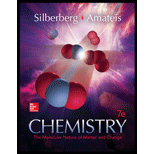
Concept explainers
(a)
Interpretation:
The number
Concept introduction:
Scientific notations are used to express the given large or small quantities in a compact way by making use of exponents.
The general representation of scientific notation is,
Here,
The decimal point is shifted towards right or left such that only one nonzero digit is present to the left of the decimal point and the number of places the decimal point is shifted is expressed as the exponent power. If the decimal point is shifted towards right from its original place a negative exponent result and vice-versa.
(b)
Interpretation:
The number
Concept introduction:
Scientific notations are used to express the given large or small quantities in a compact way by making use of exponents.
The general representation of scientific notation is,
Here,
The decimal point is shifted towards right or left such that only one nonzero digit is present to the left of the decimal point and the number of places the decimal point is shifted is expressed as the exponent power. If the decimal point is shifted towards right from its original place a negative exponent result and vice-versa.
(c)
Interpretation:
The number
Concept introduction:
Scientific notations are used to express the given large or small quantities in a compact way by making use of exponents.
The general representation of scientific notation is,
Here,
The decimal point is shifted towards right or left such that only one nonzero digit is present to the left of the decimal point and the number of places the decimal point is shifted is expressed as the exponent power. If the decimal point is shifted towards right from its original place a negative exponent result and vice-versa.
(d)
Interpretation:
The number
Concept introduction:
Scientific notations are used to express the given large or small quantities in a compact way by making use of exponents.
The general representation of scientific notation is,
Here,
The decimal point is shifted towards right or left such that only one nonzero digit is present to the left of the decimal point and the number of places the decimal point is shifted is expressed as the exponent power. If the decimal point is shifted towards right from its original place a negative exponent result and vice-versa.
Want to see the full answer?
Check out a sample textbook solution
Chapter 1 Solutions
Student Study Guide for Silberberg Chemistry: The Molecular Nature of Matter and Change
 ChemistryChemistryISBN:9781305957404Author:Steven S. Zumdahl, Susan A. Zumdahl, Donald J. DeCostePublisher:Cengage Learning
ChemistryChemistryISBN:9781305957404Author:Steven S. Zumdahl, Susan A. Zumdahl, Donald J. DeCostePublisher:Cengage Learning ChemistryChemistryISBN:9781259911156Author:Raymond Chang Dr., Jason Overby ProfessorPublisher:McGraw-Hill Education
ChemistryChemistryISBN:9781259911156Author:Raymond Chang Dr., Jason Overby ProfessorPublisher:McGraw-Hill Education Principles of Instrumental AnalysisChemistryISBN:9781305577213Author:Douglas A. Skoog, F. James Holler, Stanley R. CrouchPublisher:Cengage Learning
Principles of Instrumental AnalysisChemistryISBN:9781305577213Author:Douglas A. Skoog, F. James Holler, Stanley R. CrouchPublisher:Cengage Learning Organic ChemistryChemistryISBN:9780078021558Author:Janice Gorzynski Smith Dr.Publisher:McGraw-Hill Education
Organic ChemistryChemistryISBN:9780078021558Author:Janice Gorzynski Smith Dr.Publisher:McGraw-Hill Education Chemistry: Principles and ReactionsChemistryISBN:9781305079373Author:William L. Masterton, Cecile N. HurleyPublisher:Cengage Learning
Chemistry: Principles and ReactionsChemistryISBN:9781305079373Author:William L. Masterton, Cecile N. HurleyPublisher:Cengage Learning Elementary Principles of Chemical Processes, Bind...ChemistryISBN:9781118431221Author:Richard M. Felder, Ronald W. Rousseau, Lisa G. BullardPublisher:WILEY
Elementary Principles of Chemical Processes, Bind...ChemistryISBN:9781118431221Author:Richard M. Felder, Ronald W. Rousseau, Lisa G. BullardPublisher:WILEY





